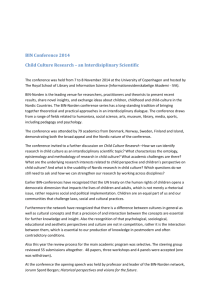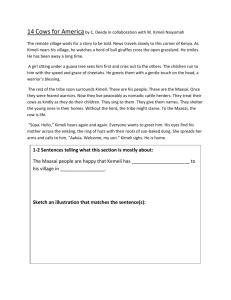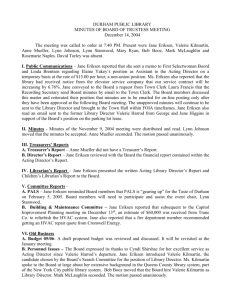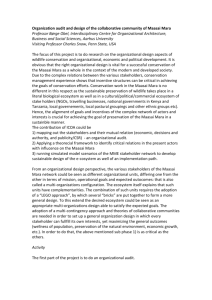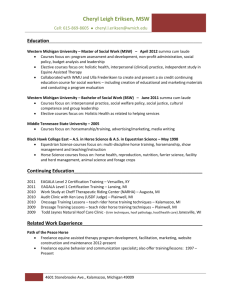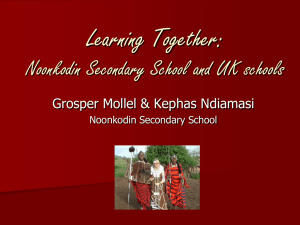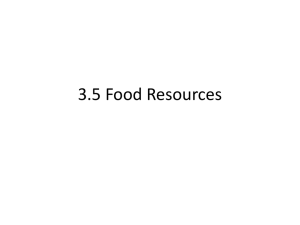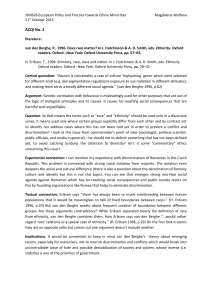Course Outline
advertisement
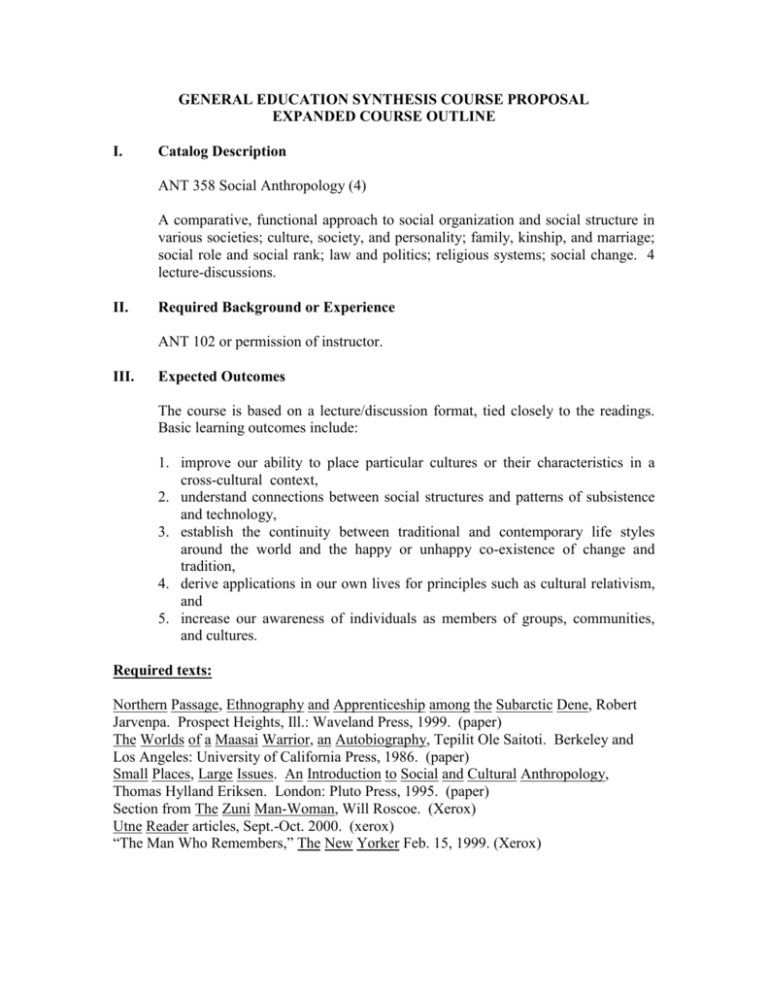
GENERAL EDUCATION SYNTHESIS COURSE PROPOSAL EXPANDED COURSE OUTLINE I. Catalog Description ANT 358 Social Anthropology (4) A comparative, functional approach to social organization and social structure in various societies; culture, society, and personality; family, kinship, and marriage; social role and social rank; law and politics; religious systems; social change. 4 lecture-discussions. II. Required Background or Experience ANT 102 or permission of instructor. III. Expected Outcomes The course is based on a lecture/discussion format, tied closely to the readings. Basic learning outcomes include: 1. improve our ability to place particular cultures or their characteristics in a cross-cultural context, 2. understand connections between social structures and patterns of subsistence and technology, 3. establish the continuity between traditional and contemporary life styles around the world and the happy or unhappy co-existence of change and tradition, 4. derive applications in our own lives for principles such as cultural relativism, and 5. increase our awareness of individuals as members of groups, communities, and cultures. Required texts: Northern Passage, Ethnography and Apprenticeship among the Subarctic Dene, Robert Jarvenpa. Prospect Heights, Ill.: Waveland Press, 1999. (paper) The Worlds of a Maasai Warrior, an Autobiography, Tepilit Ole Saitoti. Berkeley and Los Angeles: University of California Press, 1986. (paper) Small Places, Large Issues. An Introduction to Social and Cultural Anthropology, Thomas Hylland Eriksen. London: Pluto Press, 1995. (paper) Section from The Zuni Man-Woman, Will Roscoe. (Xerox) Utne Reader articles, Sept.-Oct. 2000. (xerox) “The Man Who Remembers,” The New Yorker Feb. 15, 1999. (Xerox) Other reading material may be provided in class as handouts or recommended. You will be doing research or exercises that require you to do additional reading. If you want to use Internet resources, please check them out with the instructor. Remember, anyone can publish anything on the Internet, which is not the case with scholarly journals, books, or most other print media. Course objectives After you complete this course successfully, you will be able to: 1. Apply critical principles to your own life and society. 2. Conduct a small-scale ethnographic research project, either individually or as part of a team. 3. Read, watch, or hear popular and journalistic programming related to the anthropology of social life from a more expert standpoint. 4. Understand what some of the differences between cultures mean, and how they are relevant to individual behavior. This course is part of the standard required preparation for future anthropologists, whether you are going to graduate school or an applied field (CRM, etc.). It also provides an excellent background for future teachers, social workers, planners, international business managers, geographers, and many others. Students from all majors should be able to compete successfully with anthropology majors in the course, although ANT 102 is recommended for all. Course Outline Unless otherwise specified, assignments are due on the next class meeting date. Date Topic Assignment Jan. 3 General introduction to the field. Social structure and social organization. Maasai: pp. xiii-13. Eriksen: Ch. 1, due 1/8. Jan. 5 The sociocultural map today. How did it get that way? Debatable propositions. Maasai: pp. 13-25. Exercise #1 (observation). Jan. 8 Social groups, roles, and relations. Small scale versus complex society. Maasai: pp. 25-36. Eriksen: Ch. 2. Jan. 10 Research in social anthropology. Epistem- Maasai: pp. 36-43. ology and methodology. Discuss projects. Jan. 12 The basic lifeways of humankind: hunter/ Maasai: pp. 43-56. gatherers, pastoralists, farmers, and industrial Eriksen: Ch. 3. modes of production. Project #1 due 1/29. Jan. 17 Kinship and marriage: the core subjects of social anthropology and why. Controversies in the field. Maasai: pp. 56-66. Begin Utne Reader articles to finish by 1/24. Jan. 19 Descent types and groups. Alliance theory. Maasai: pp. 66-81. Kinship diagramming for fun. Eriksen: Ch. 4. Jan. 22 Forms of marriage. Marriage as exchange, Maasai: pp. 88-95. ending marriage, second marriages. Eriksen: Ch. 5. Jan. 24 Forms of the family, cultural ecology of family form. Life cycle rituals. Maasai: pp. 95-102. Eriksen: Ch. 6. Jan. 26 Gender, sex, sexuality, love, reproduction, marriage, and are they related? What's learned and what's not? Maasai: pp. 102-112. Eriksen: Ch. 7. Begin Zuni section due 1/31. Jan. 29 Age and generation as social classifiers. Age sets and age grades. Maasai: pp. 112-118. Eriksen: Ch. 8. Jan. 31 Status and social stratification. Social roles, rules, and relations between groups. Maasai: pp. 118-125. Eriksen: Ch. 9. Feb. 2 Power and authority in different cultural settings. Relation to age and gender. Maasai: pp. 125-133. Eriksen: Ch. 10. Feb. 5 Case study of Wolof society. Issues in ethnographic research. Maasai: pp. 133-144. Eriksen: Ch. 11. Feb. 7 Review. Feb. 9 Mid-term exam. Feb. 12 Economic systems in the traditional world. Dene: Prologue. Historical materialism versus technoEriksen: Ch. 12. economic determinism. Project #2 due 3/9. Feb. 14 Traditional belief systems. What is religion? Dene: Ch. One. Philosophical dimensions of all belief Eriksen: Ch. 13. systems. Exercise #2 due 2/21 (ritual). Feb. 19 Ritual and myth. Taboos and religious obligations (e.g., sacrifice, pilgrimage). Dene: Ch. Two. Eriksen: Ch. 14. Feb. 21 Magic, witchcraft, and healing. Eriksen: Ch. 15. Feb. 23 Socialization and education in the crosscultural context. Communication. Dene: Ch. Three. Eriksen: Ch. 16. Feb. 26 Culture and personality. Norms and deviance. Feb. 28 Social control mechanisms. Does biology explain aggression and disorder? Dene: Ch. Five. Eriksen: Ch. 17. Mar. 2 Cultures in contact and conflict. Dene: Ch. Six. Mar. 5 Social issues in the modern world. Eriksen: Ch. 18. Mar. 7 Applications of social anthropology to the contemporary context. Dene: Aftershock. Eriksen: Epilogue. Mar. 9 Review. Dene: Ch. Four. FINAL EXAM March 16 11:30 – 1:30 Format of the class Most of the class will consist of presentation of background material by the instructor or guest lecturers. This is likely to be new information for most of you, so do not hesitate to ask questions or bring up issues that occur. Other class periods will be spent in discussion of the readings, viewing films, or small group projects. There may be occasional ungraded quizzes on the reading and lectures for assessment purposes. I am attempting to arrange at least one field trip. Requirements for an excellent grade 1. Regular attendance. Participation in discussions is very desirable. If this is difficult for you due to language, shyness, or a disability, please see the instructor. If you will be unable to attend class, please inform me ahead of time (except in cases of emergency or illness). You are expected to take your own notes, unless you arrange with a classmate to borrow theirs, during an illness or other excused absence. 2. Completing all assigned work on time, including readings, projects, exercises, and test preparation. 3. Use of good communication skills in written and oral communication. If you have any English language difficulties, help is available (see me for further information). Always proofread written work. 4. Good performance on the mid-term, final exam, ethnographic report, and fieldwork project/report. 5. Adherence to high standards of student/scholar ethics. If you are unsure of the definition of plagiarism or other violations, please ask me. We will discuss the proper form for citation of sources in class. Group study is highly recommended. The end product should reflect your own effort only. Evaluation Your assignments for the course will consist of: 1. 2. 3. 4. 5. 6. 7. Mid-term exam . . . . . . . . . . . . . . . . Final exam . . . . . . . . . . . . . . . . . . . . Ethnography project . . . . . . . . . . . . . Fieldwork project . . . . . . . . . . . . . . . Exercise #1 (pass/fail) . . . . . . . . . . . . Exercise #2 (pass/fail) . . . . . . . . . . . . Attendance and participation . . . . . . . 20% 25% 15% 20% 5% 5% 10% 100%

